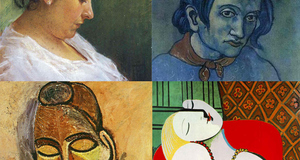"It's a Wise Child:" A Levinasian Analysis of J. D. Salinger's Glass Family StoriesIII. The Construction of Ethics within the Face-to-Face Relationship“She was not one for emptying her face of expression.” – Salinger In Levinas’s Ethics as First Philosophy, the face-to-face relationship is the origin of and the site at which the ethical moment takes place. Throughout the Glass family works, a similar existential importance is given to the face of the other in interpersonal interactions. The haiku at the site of Seymour’s suicide is perhaps one of the best examples of this. Written by Seymour, quoted by Buddy, and read by Zooey, it gives us a brief glimpse into Seymour’s state of mind just before he takes his life: “The little girl on the plane / Who turned her doll’s head around / To look at me” (Salinger, 1961/2010, p. 43). The haiku can be read in two ways. One, that the little girl on the plane has a doll, and then playfully turns its head to face Seymour, or two, that Seymour is describing the girl herself as being like a doll, and she turns her own head to look at Seymour. The latter interpretation offers a parallel to Levinas’s description of the ethical relationship as existing in the face of the human other: “The proximity of the other is the face’s meaning… there is the nakedness and the destitution of the expression as such, that is to say extreme exposure, defencelessness, vulnerability itself” (Levinas, 1989, p. 82-83). In the first interpretation, however, the ethical compulsion to be subject to the Other, the little girl, is signified through her transfer of her gaze to the doll, and infuses it with even more pathos and innocence because of that childish gesture. The impact of the brief poem is immediate and forceful. It creates a clear image in the reader’s mind of the directness of the gaze, and whether it is the doll’s or the girl’s, that directness and the human connection that it indicates is the essence of the haiku. In Franny and Zooey, Buddy finds this haiku on the desk in the hotel room where Seymour shot himself. This fact opens up many interesting avenues of thought centered around his suicide. Primarily, it brings up the possibility of a Levinasian sort of abnegation where Seymour has a “fear for all the violence and murder my existing might generate… It is the fear of occupying someone else’s place with the Da of my Dasein; it is the inability to occupy a place” (Levinas, 1989, p. 82). The subjection to the Other that has its immediacy in the face-to-face relation is here taken to its natural extension and culminates in the destruction of the self. The last few events of Seymour’s life mirror Levinas’s concept of proximity in that he was caught in the gaze of the little girl and was made to confront his own reasons for existence, his being in the world when that necessarily meant his causing harm and suffering to others.Seymour’s existence in the world especially indicates suffering to others on not just an abstract, indirect level such as the one Levinas describes when he says, “My being-in-the-world or ‘my place in the sun’, my being at home, have these not also been the usurpation of spaces belonging to the other man whom I have already oppressed or starved, or driven out into a third world… ?” (Levinas, 1989, p. 82), but on a literal level as well. In the short story “A Perfect Day for Bananafish,” where Buddy narrates the events leading up to Seymour’s death, Seymour has just recently returned from army service in World War II, and it is clear from the way his wife and mother-in-law talk about him that he has been fairly disturbed by the war’s events. Having been ordered to kill in the war, Seymour has in all likelihood broken the sacred injunction of the face-to-face relation with another human being, “thou shalt not kill” (Lindahl, 2002), which is one’s responsibility to the Other: “Responsibility for the Other, for the naked face of the first individual to come along… as if I had to answer for the other’s death even before being” (Levinas, 1989, p. 83). Seymour himself tells another little girl on the beach an allegorical story which describes his shock and guilt after enduring the horrors of war. It centers around a fictional species of fish called the bananafish, which look like normal fish except when they enter a hole full of bananas. They then greedily eat so many bananas that they are too fat to get out, and eventually get banana fever and die. This story illustrates Seymour’s “fever” from having killed people in the war, so many that he can now never fit back through the hole to rejoin civil society. His story underlines the terrible, irrevocable state of having taken a human life. He has abdicated his responsibility to the Other. The face-to-face relation and the ethical compulsion to respond to the Other is also present in Buddy’s actions throughout the Glass family stories. In Raise High the Roofbeam, Carpenters, when faced with the invitation to follow Seymour’s fiancee’s Matron of Honor to a bar after the groom fails to show up to the wedding, Buddy’s response is an instant yes, even though he has just had a heated altercation with her. To him, this response is only natural: “My singularly immediate acceptance of the invitation strikes me as much more easily explainable. I prefer to think it was basically a religious impulse. In certain Zen monasteries, it’s a cardinal rule, if not the only serious enforced discipline, that when one monk calls out ‘Hi!’ to another monk, the latter must call back ‘Hi!’ without thinking” (Salinger, 1963/1991, p. 46). Buddy’s instant compulsion to respond in the affirmative when invited by someone, without any real consideration of his own feelings on the matter, recalls Levinas’s responsibility to the Other as well as subjection to the Other. The same compulsion is reflected in Buddy’s interactions with the bride’s father’s hearing- and speech-impaired uncle, whom Buddy has never seen before but strikes up a wordless friendship with purely through reciprocating the uncle’s wide grins and nods: Occasionally, I remember, as we walked along, my friend and I looked up and down, respectively, at each other and exchanged idiotic expressions of pleasure at sharing one another’s company (Salinger, 1963/1991, p. 50).
Levinas’s concept of proximity is here exhibited by Buddy in his visceral reflex to respond to the old man’s expressions of friendly love and kindness with similar effusive enthusiasm. This is in contrast to the other members of the wedding party, who – when they acknowledge the old man’s presence at all – respond only with contempt. In this sense, Buddy acts out Levinas’s injunction that “[t]he proximity of the other demands a response… proximity is responsibility, or the ability to respond… The very meaning of being a social subject is to be-for-the-other” (Beavers, 1995, p. 6). The face-to-face relationship to the other is thus in the foreground throughout the novellas and stories. IV. Resisting a Totalization of the Other“But what I don’t like – and what I don’t think Seymour and Buddy would like either, as a matter of fact – is the way you talk about all these people. I mean you don’t just despise what they represent – you despise them. It’s too damn personal, Franny.” – Salinger What is meant by a “totalization” of the other? In Levinas’s work, he contends that totalization or thematization occurs when one takes the idea or constructed representation of an other to be that other. Knowledge of an other is “a hold on being which equals a constitution of that being. This Transcendental Reduction suspends all independence in the world other than that of consciousness itself” (Levinas, 1989, p. 79). In presuming knowledge of an other, one commits an act of violence against that other, replacing him or her with one’s image of him or her, and consequently denying the other personhood: “Levinas calls this violence ‘totalization’ and it occurs whenever I limit the other to a set of rational categories, be they racial, sexual, or otherwise” (Beavers, 1995, p. 3). To impose one’s own ideas on the identity of a being rather than to appreciate that being as an end in and of itself is what Levinas terms totalization. The suspension of the other’s independence is explored and almost valorized in an episode taken from Seymour’s diary, where Seymour describes hearing Zooey answer a question on the quiz show It’s a Wise Child: Zooey was in dreamy top form. The announcer had them off on the subject of housing developments, and the little Burke girl said she hated houses that all look alike – meaning a long row of identical ‘development’ houses. Zooey said they were ‘nice’. He said it would be very nice to come home and be in the wrong house. To eat dinner with the wrong people by mistake, sleep in the wrong bed by mistake, and kiss everybody goodbye in the morning thinking they were your own family. He said he even wished everybody in the world looked exactly alike. He said you’d keep thinking everybody you met was your wife or your mother or father, and people would always be throwing their arms around each other wherever they went, and it would look ‘very nice’” (Salinger, 1963/1991, p.68). At first glance, the anecdote seems like that of a silly childish daydream, but on deeper analysis, especially within the context of the type of early education that Zooey has received, it speaks to the overarching theme of Levinasian subjection to the Other, which could also be construed as a sort of altruistic, sacrificial, unconditional love for the Other. On the subject of love as responsibility to the Other, Levinas (1979) says, “Love remains a relation with the Other that turns into need, and this need still presupposes the total, transcendent exteriority of the other, of the beloved” (p. 254). Zooey’s idealized depiction of what life would be like if every house looked alike, leading them to love strangers as much as they love their families, is demonstrative of an early understanding of the nature of first philosophy and the principles of Levinasian ethics, although not articulated in those terms per se. His desire to then erase superficial differences in human beings as well indicates a deeper desire to make resisting a totalization of the other easier, where our own perceptions of others, their differences and the inherent violence within that wouldn’t pose an obstacle to carrying out our responsibility towards them. However, it also brings up the position of privilege from which the Glass siblings view the world, being upper-middle class, white Manhattanites. The idea of racial and sexual differences being altogether invisible, creating a world in which “everybody in the world looked exactly alike,” is a sensitive one, as it would also erase histories of social oppression and bring up the question of which race and sex would be the ones to which everyone’s appearances conformed. The totalization of others in the Glass family stories is also bound up with academia and the questioning of traditional knowledge systems. One of the central problems that Franny grapples with in Franny and Zooey is her tendency to reduce every classmate, professor, and teaching assistant she comes into contact with at college to an egotistical automaton driven only by ambition and academic pretension. She complains, “I’m just sick of ego, ego, ego. My own and everybody else’s. I’m sick of everybody that wants to get somewhere, do something distinguished and all, be somebody interesting” (Salinger, 1961/2010, p.20). Franny forms her fixed views of others and then judges them by her own personal ethical yardstick, one which privileges intellectual work for its own sake rather than as a means to an end – in this case, a career that leads to fame, academic prestige, or money. Even people’s appearances, and not only their actions, come under her microscope, until she starts referring to them by stereotypes: “Everybody else on the train, Franny said, looked very Smith, except for two absolutely Vassar types and one absolutely Bennington or Sarah Lawrence type” (Salinger, 1961/2010, p. 6). Zooey exhibits this behavior as well when he pretends to forget who Franny’s boyfriend Lane is when Bessie mentions him and then, on being called out on that, dismisses him as a “charm boy and a fake” (Salinger, 1961/2010, p.63). He also criticizes many of his colleagues who work in television as second-rate artists who are just pandering to the masses, mirroring Franny’s criticism of her fellow actors who put on college theater productions of which she’s ashamed. In a somewhat redeeming turn of the novella, however, both Franny and Zooey realize that these generalizing behaviors oppress the people they are criticizing. Franny exclaims, “Just because I’m choosy about what I want – in this case, enlightenment, or peace, instead of money or prestige or fame or any of those things – doesn’t mean I’m not as egotistical and self-seeking as everybody else. If anything, I’m more so!” (Salinger, 1961/2010, p.97), while Zooey says, “I go because I sit in judgment on every poor, ulcerous bastard I know… But there’s something – Jesus God – there’s something I do to people’s morale downtown that I can’t stand to watch much longer” (Salinger, 1961/2010, p. 90). Considering the early ethical/religious education these two characters have had, it is no wonder that neither of them can stand phoniness in others nor judgmental tendencies in themselves and consequently are suffering a sort of crisis of cognitive dissonance. From a very early age, when Seymour and Buddy took over their education, they were instructed to seek truth and authenticity as well as resist totalizing others. In Raise High the Roofbeam, Carpenters, Buddy narrates a Taoist tale that Seymour read to baby Franny, where Kao, a wise man, is assigned to choose a superlative racehorse for the king, a mission he succeeds in, yet he describes its outward appearance incorrectly, leading the king to doubt his capability to tell a good horse from a bad one. It is then revealed that, “What Kao keeps in view is the spiritual mechanism. In making sure of the essential, he forgets the homely details; intent on the inward qualities, he loses sight of the external” (Salinger, 1963/1991, p. 5). The tale illustrates that a true Zen master sees only the essence of a being, to the point where its superficial qualities, whether it is the being’s appearance or behavior, don’t even register. However, this kind of erasure of differences among people, while it may lead to universal love and understanding, would necessarily lead to a loss of artistic differences and aesthetic beauty, which have their own value. The wise man in the Taoist tale couldn’t differentiate between a black stallion and a dun-colored mare, and Zooey’s homogeneous utopia doesn’t allow for any aesthetic differences. Seymour calls this artistic sensibility “poetry” and expounds upon the subject in his diary: I’ll champion indiscrimination till doomsday, on the ground that it leads to health and a kind of very real, enviable happiness. Followed purely, it’s the way of the Tao, and undoubtedly the highest way. But for a discriminating man to achieve this, it would mean that he would have to dispossess himself of poetry, go beyond poetry. That is, he couldn’t possibly learn or drive himself to like bad poetry in the abstract, let alone equate it with good poetry. He would have to drop poetry altogether. I said it would be no easy thing to do (Salinger, 1963/1991, p. 74). Seymour’s discourse on cultivating indiscrimination and its ramifications for appreciating poetry or art have direct implications for Franny’s and Zooey’s dilemma in Franny and Zooey. Their conflict lies in the schism between knowing good acting, writing, and academic thinking when they see it and still being able to respect the people behind bad acting, writing, and thinking, especially when people display pride and ego about themselves and their work. They find themselves unable to be as indiscriminate as their education in the ethics of relating to the Other demands, because their discriminating tastes in art spill over so much so that they sit in judgment on the artist. As Bessie says to Zooey, “Neither you nor Buddy know how to talk to people you don’t like… Don’t love, really,” (Salinger, 1961/2010, p. 65). Along with Seymour, Franny, and Zooey, Buddy struggles with the same problem of totalizing the other. However, his struggle is much less overt because Buddy is not usually an active character, but the narrator or the implied author of most of the Glass family stories. The situation is doubly complicated because of his unreliability as a narrator. In Seymour – An Introduction, it is revealed that he wrote “A Perfect Day for Bananafish,” but most of his family feel that the Seymour character in that story resembles Buddy more closely than he does Seymour (Salinger, 1963/1991, p.112). However, the complexity of the character cannot be doubted, and Franny, Zooey and Bessie are also written as complex characters, with different facets of their personality showcased and their inner struggles explored. In contrast, most of his other characters outside the Glass family are fairly one-dimensional. Seymour’s wife and mother-in-law, as well as the female characters from their side of the family in the wedding party in Raise High the Roofbeam, Carpenters, are primarily portrayed as flighty, gossipy, and concerned with appearances. The male characters are inconspicuous, are given very minimal lines, and nearly fade into the background. Franny’s and Zooey’s colleagues and classmates are frequently vilified in Franny and Zooey as egotistical, talentless people. Thus, Buddy himself totalizes his characters to the point where almost all the characters portrayed in a positive light are within the Glass family, and the characters portrayed in a negative light are outside the family. His struggle to resist totalizing the other is just as complicated by his commitment to art as Franny’s and Zooey’s.Continued on Next Page » Suggested Reading from Inquiries Journal
Inquiries Journal provides undergraduate and graduate students around the world a platform for the wide dissemination of academic work over a range of core disciplines. Representing the work of students from hundreds of institutions around the globe, Inquiries Journal's large database of academic articles is completely free. Learn more | Blog | Submit Latest in Literature |


















